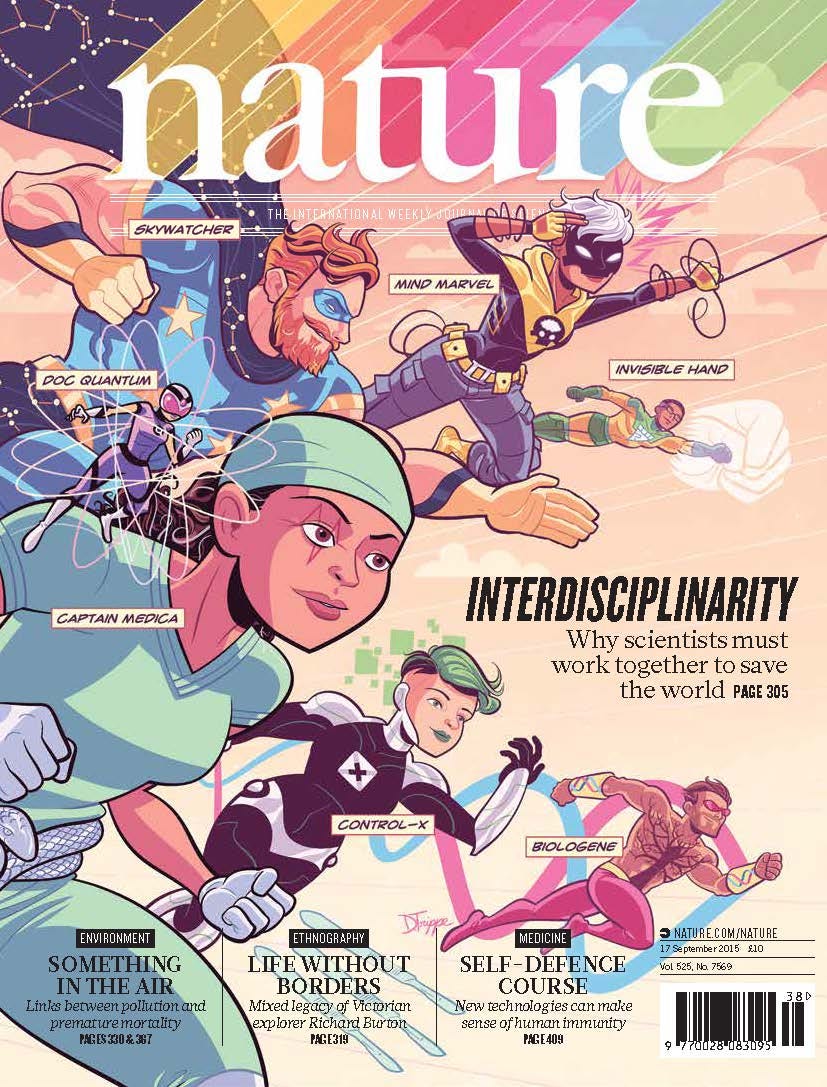#21: We Sing About Beauty, and We Sing About Truth
A quick exploration into journal cover art, and its role in sharing science.

Science and art are strongly intertwined, and expressing one’s science through art is, simply put, fundamentally satisfying.
American Chemistry Society
Creative expression within the scientific realm is not limited to academic posters, slides for presentations, visual abstracts, or papier-mâché volcanoes stuffed with baking soda. Even when the science itself is presented in the confines of a journal article’s traditional detached prose, there are opportunities for creative self-expression and engagement of a wider audience via the journal’s cover art.1
Recently, the icy blues and warm plums, and the dramatic lighting, of this cover caught my eye while browsing the #SciComm hashtag:

All Designed to Blow Our Minds
I had to know more about this cover. Why did the artist choose stained glass? Is the study commenting on religious institutions and their role in influencing science?
It turns out that the answer was simpler: the artist appreciated the beauty of church windows, and then saw in them a metaphor that clearly tied back to the science. Munafò explains that:
…only when light shines through the glass you can see a clear picture emerging from this chaos. Starting from the back, windows that do not get much light cast chaotic and uncoordinated shadows. In the middle, a little more light passes through and some sense begins to emerge from the reflection. Finally, well illuminated windows cast a clear picture of broken DNA helix.
Marzia Munafò (@munafomarzia)
While many covers are made digitally, they can also be photographs of objects. In the case of Lynch et al.’s recent paper, a photograph of a real stained glass piece that was created to illustrate the mutually beneficial relationship between the Hawaiian bobtail squid and a bacteria called V. fischerii.2

As I’ve mused a number of times in the blog, science and art are complementary colours that should be mixed more often. Art infuses humanity into a discipline that sometimes misplaces it in search of objectivity.
Designing a cover image allows for scientific research to be seen in a new light. The science is not just words in a manuscript anymore—it's been lifted out of the paper and shown in a way that accessible to both researchers and the general public.
Dr. Beata Mierzwa, in How to turn your research discovery into an eye-catching piece of cover art
Teaching Us a Better Way
Where do scientists score cool cover art, though?
Well, if the researcher relies on an external artist, like above with Munafò and Hartman, the process likely starts with broader conversations with the researchers that lead to further refinement. In their Twitter thread, Munafò shares that the process begins with a discussion of the overarching concept with the authors. Then, they drafted concepts to share with the authors, refining ideas based on feedback, until a direction is agreed upon. Yet, even as the final piece is being produced, the artist continued to check in regularly to ensure accuracy and fidelity to the underlying science.
In another behind-the-scenes article, Joe Meyer adds that understanding the style of the journal is also key to the process. As homework, then, checking out previous covers is important fact-finding. Do they like photographs or digital art? (There’s a great tutorial here on creating cover art worthy photos.) Do they prefer a realistic, a cartoonish, or an abstract style? And, how can the final design allow for layout of the journal title, sub-titles and other necessary text on the cover?

In other cases, the artwork may be produced by the scientist themselves; for example, my friend Dr. Alli Murugesan is a scientist who looks for cancer-fighting compounds in naturally-occurring products. In one study, she isolated a potential cancer fighter from the sticky residue that glues together honeycombs (propolis), and then fed her artistic side by designing a cover to go with it:

Of course, in the effort to further democratize science, having patient partners not only author papers, but illustrate them, can be extremely powerful. Sue Robins offers additional layers into an already personal essay on a healthcare experience, with the cover art consisting of just some of the photos taken of her clinical journey:

We Sing About Beauty, and We Sing About Truth
While one wouldn’t assume there was much to a journal cover, it turns out that it’s another opportunity to share a story about the science within. Like a book or an album, it gives hints to its contents, and sets a tone for what you’re about to read. Even in a digital world, journal covers are a way to educate and infuse a dash of wonder into discoveries made. Some could argue practicalities but lately, I think we can all use a bit more magic and joy in our medicine.
And on that note, let’s finish with a song, and medicine show, that always sparks joy for me3:
A bucket of cold water to throw on this, but important to highlight all the same: Checking on a few journal websites (Royal Society of Chemistry; the publisher Wiley), there are costs - $800-$1,000+ - to have the art that you pitched and then created yourself or paid another to create, published as the cover, is particularly distasteful, even for academic publishers.
The article describes how a mutation in a certain part of a bacterium’s structure can protects it from organisms (phages) that attack (or, rather, eats) bacteria. It then shows that all of this doesn’t matter if the bacteria hangs around this squid; something about the interaction between squid and bacteria makes the phages less peckish.
Dr. Hook is the bomb, and I will not accept criticism. I saw Ray (the eye patch one) at a packed show about 15 years ago with my sister, and that dude could still get it. And with the number of drinks and bras sent to the stage, I’m sure he did.




I will never look at a journal cover in the same way again. Well done!
Absolutely fascinating, Bryn! I've never really thought about cover art in this way. :D